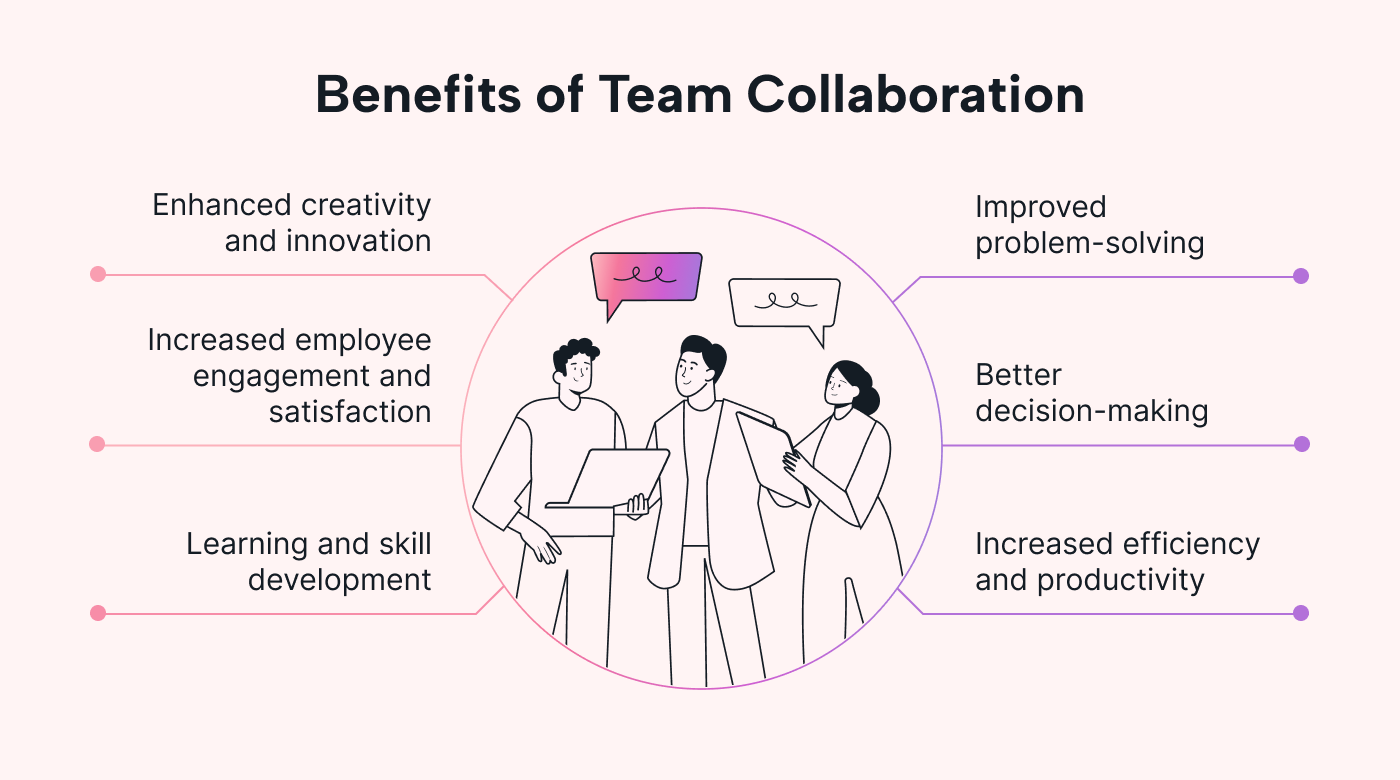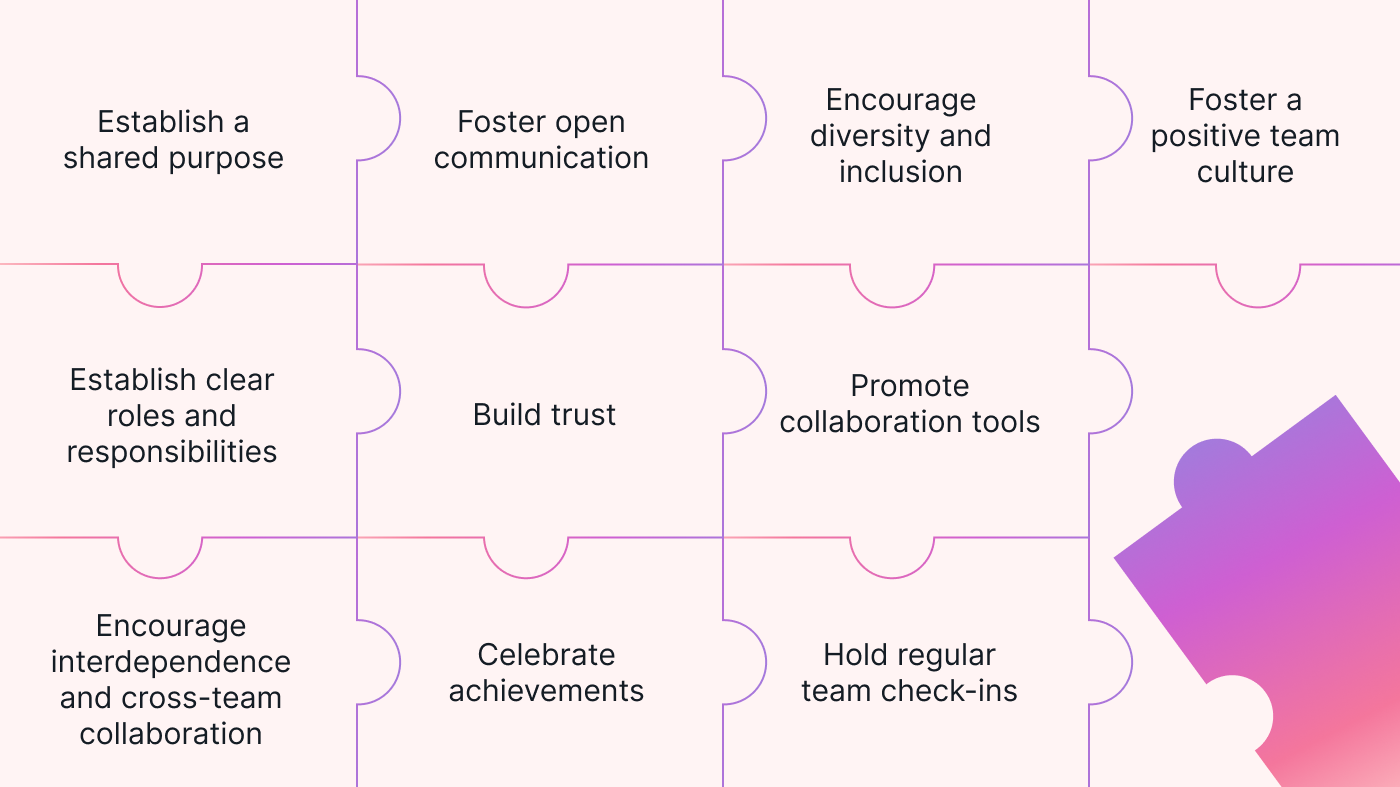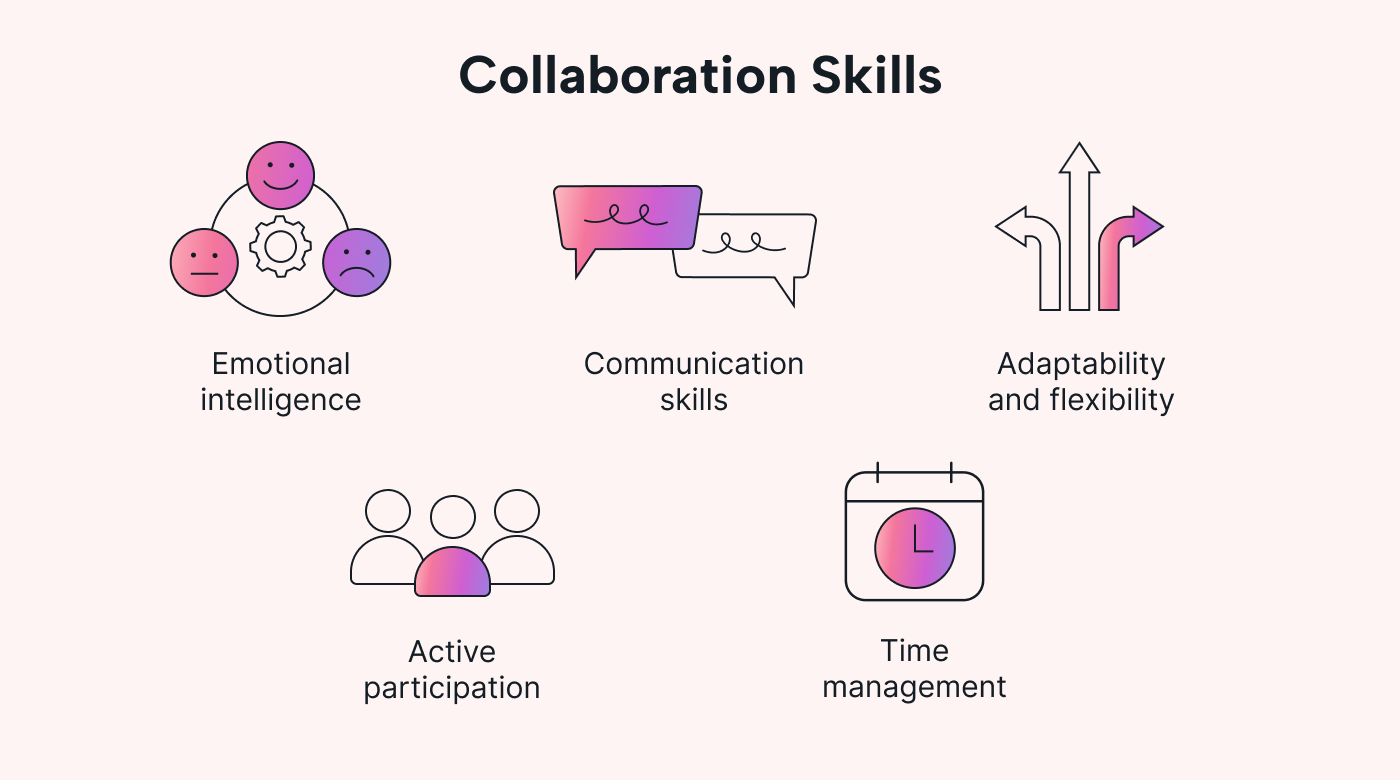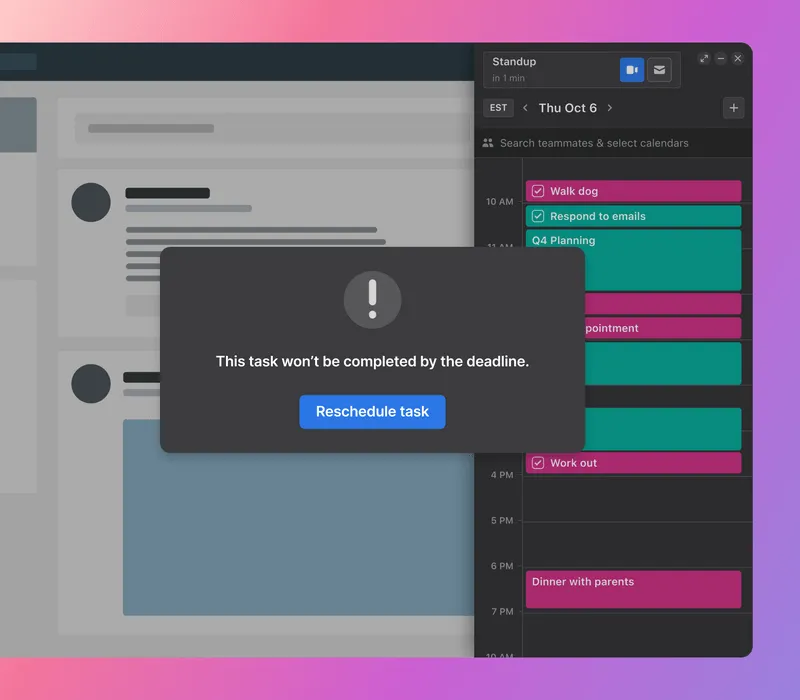"The strength of the team is each individual member. The strength of each member is the team." — Phil Jackson
We've all heard "Teamwork makes the dream work" and "It takes a village." While these statements might be cliche, that doesn't mean they aren't true.
In a world where we're often racing to be the best, we sometimes forget that the real magic happens when we stop competing and start collaborating.
Team collaboration is about bringing together different ideas, skills, and experiences and blending them into something extraordinary. It's where lightbulb moments happen — when we build on each other's strengths and create something bigger than the sum of the parts.
But what does it take to build a collaborative team? Let's uncover the potential of true collaboration and what you can do to promote team synergy.
What is team collaboration?
Team collaboration is the process of individuals working together toward a common goal or objective. Each team member brings unique expertise and skills to the table, leading to better outcomes than what can be accomplished individually.
Effective team collaboration, whether in-person or remote, involves ongoing effort and investment from all team members.
Why is team collaboration important?
Is team collaboration really all it's hyped up to be?
When done well, there is a lot to gain. Here are the benefits of team members working together effectively:
 |
Improved problem-solving
Collaborative teams can tackle complex problems more effectively than non-collaborative teams. Pooling their knowledge and expertise helps team members analyze problems from different angles, generate possible solutions, and determine the best course of action.
Better decision-making
Team collaboration facilitates collective decision-making — people have the opportunity to consider diverse perspectives and insights, which broadens the scope of what’s possible.
Involving multiple team members in the decision-making process means the team can make more informed and well-rounded decisions that aren't based on individual biases.
Increased efficiency and productivity
Team members who work together can divide tasks, share responsibilities, and leverage each other's strengths. Collaboration helps teams avoid doing the same thing twice and allows them to complete different tasks at the same time. This efficiency leads to higher productivity.
Enhanced creativity and innovation
Collaboration brings together diverse perspectives, skills, and experiences, fostering creativity and innovation. When team members collaborate, they can generate new ideas, challenge each other's assumptions, and develop more effective solutions.
 |
Increased employee engagement and satisfaction
Collaboration fosters a sense of belonging and shared purpose among team members. When team members feel their ideas and efforts are appreciated, they become more engaged and feel more valued.
This can boost team morale and motivation. But it also can improve business outcomes. A report by Gallup found that organizations with strong, engaged teams enjoy 24% lower turnover and 21% higher profitability.
Learning and skill development
When people collaborate on projects, they have more opportunities to learn from each other, share what they know, and develop new skills. Holding regular knowledge-sharing sessions allows more experienced team members to share their expertise with the rest of the team. This strengthens the team's skill set as a whole.
10 strategies for building collaborative teams
If you're an employer who wants to benefit from these advantages, then you need to put in the work with a hands-on approach. After all, you can't force your team into a room and say, “Everyone, work together and play nice.”
Here are some pragmatic strategies for getting your team working together like a well-oiled machine:
 |
1. Establish a shared purpose
Effective collaboration requires all team members to align around a common goal.
Clearly communicate the team's purpose and objectives, emphasizing how each member will contribute to its success. For example, a shared purpose in a marketing team could be to increase brand awareness by 20% over the next quarter. This goal provides clear direction and motivates the team to work collaboratively toward achieving it.
Actionable Insight: Hold a meeting to discuss and define the team's shared purpose, allowing each member to contribute. Regularly remind the team of the goal to keep everyone focused and aligned.
2. Foster open communication
Establish collaborative communication channels and tools where team members can freely exchange ideas, provide feedback, and share information.
A project management tool like Motion can centralize communication, allowing team members to stay aligned on tasks, project plans, and deadlines.
Actionable Insight: Implement regular team meetings — both in-person and virtual — to facilitate open communication. Encourage participation, active listening, and diverse perspectives. Leverage Motion's communication features, such as shared chat channels and file sharing, to enhance collaboration and transparency.
3. Encourage diversity and inclusion
Embracing diversity within a team brings together a variety of perspectives, experiences, and skills, leading to more innovative solutions. Create an inclusive environment where all team members feel valued and respected, regardless of their background. Encourage diverse viewpoints and seek input from team members with unique perspectives.
Actionable Insight: Create opportunities for team members to share their one-of-a-kind experiences and ideas. For example, organize team-building activities that celebrate different cultures or host lunchtime presentations where team members can share their expertise on particular topics.
4. Foster a positive team culture
Encourage a work culture where there is mutual respect among team members and everyone feels comfortable sharing their ideas. Promote a growth mindset where mistakes are seen as opportunities for improvement.
Actionable Insight: Organize team outings or virtual social events to promote bonding and strengthen relationships. Regularly acknowledge and celebrate team achievements to boost morale and motivation.
5. Establish clear roles and responsibilities
Clearly define each team member's roles and responsibilities to ensure clarity and accountability. Communicate expectations regarding deliverables, deadlines, and quality standards to avoid misunderstandings and enhance collaboration.
Actionable Insight: Conduct individual meetings with team members to outline their specific roles and responsibilities. Provide a written document or job description that outlines each person's contributions and how those contributions relate to the team's goals.
6. Build trust
Trust is the foundation of a collaborative team. In fact, 68% of employees say that low trust hurts their daily effort. Encourage team members to support and rely on each other. Show that you trust your team by delegating tasks without micromanaging.
Actionable Insight: Lead by example. Demonstrate trustworthiness by being reliable, honest, and transparent in your actions and communications. Follow through on your commitments, be open to feedback, and treat others with respect.
7. Promote collaboration tools and technologies
Provide access to cutting-edge tools and technology for seamless collaboration. Regularly assess your team's needs, and conduct training sessions when required.
With the right collaboration platform, employees could save 5–10% of their time, equating to 2–4 hours per 40-hour work week.
 |
Actionable Insight: Invest in Motion and its collaborative features to keep your team in sync. Share best practices and tips on using the tool's features for enhanced collaboration. With features such as shared chat channels, task assignment, and file sharing, Motion streamlines team interactions, enhances transparency, and improves coordination.
8. Encourage interdependence and cross-team collaboration
Promote collaboration not only within the team but also across different teams and departments. Encourage a culture of interdependence.
Actionable Insight: Create opportunities for cross-team collaboration through joint projects and encourage team members to seek input from colleagues in other departments. Celebrate successful collaborations to reinforce the importance and value of interdependence.
9. Celebrate achievements
Recognize individual contributions and milestones to boost morale and motivation. Celebrating successes creates a sense of accomplishment and reinforces the value of collaboration.
 |
Actionable Insight: Implement a recognition and rewards program to acknowledge team and individual achievements. This can include verbal praise during team meetings, personalized notes of appreciation, or even small incentives or team outings.
10. Hold regular team check-ins to gather feedback
Encourage team members to provide feedback on team dynamics, processes, and collaboration. Create a safe space for open and constructive feedback, and actively listen to concerns and suggestions.
Actionable Insight: Schedule regular team meetings to discuss progress and address any issues that need attention. Act on the feedback you receive to improve team collaboration and efficiency.
Important skills for team collaboration
It takes an entire team to make collaboration happen, and team members need to step up and develop certain skills to contribute effectively. Skills that teams should work on to create a strong, collaborative dynamic include the following:
 |
Emotional intelligence
Emotional intelligence involves not only understanding and managing one's own emotions but also recognizing and empathizing with others' emotions. It helps foster positive relationships and promotes a supportive team environment.
Communication skills
Strong communication skills are essential for successful collaboration. These include verbal and written communication, active listening, and the ability to convey ideas clearly.
Adaptability and flexibility
Things don't always go smoothly during collaborative projects, so team members need to be adaptable and flexible. Openness to change, new ideas, and finding creative solutions can help teams overcome obstacles.
Active participation
Active participation means engaging fully in team activities, discussions, and decision-making. Regularly contributing ideas, asking questions, and providing feedback demonstrate commitment and introduce new perspectives.
Time management
Effective time management is crucial for collaborative projects. Team members should be able to prioritize tasks, set realistic deadlines, and manage their time efficiently to ensure the timely completion of deliverables.
 |
Motion's AI Task Management App can prioritize a team's tasks for them, saving them time and helping them meet their deadlines.
Common challenges with team collaboration and how to address them
Team collaboration isn't always a walk in the park. Challenges are bound to crop up, but how you deal with them makes all the difference.
Here are some common obstacles that teams face when collaborating, along with some practical strategies to help you overcome them:
Conflicting goals and priorities
Different objectives among team members can lead to conflicts and inefficiencies. Ensuring that everyone's on the same page will help avoid this. Discuss your team's goals often, clarify what's most important, and be open to adjusting tasks if necessary.
Ineffective leadership
Poor leadership can lead to confusion, a lack of direction, and demotivated team members. Effective leaders should provide clear guidance, set expectations, and empower their team members. Additionally, they should facilitate decision-making processes, listen to concerns, and offer support when needed.
Limited resources
Having too few resources like time, money, and people can make collaboration difficult. To overcome this challenge, prioritize tasks, allocate resources effectively, and set realistic goals. If need be, communicate resource constraints to stakeholders, and explore alternatives like outsourcing, automation, or securing more resources.
Cultural and language barriers
The cultural and language differences that often accompany diverse teams can make collaboration more difficult. To overcome this, foster cultural sensitivity by promoting awareness, respect, and inclusion.
 |
If there are language barriers among your team members, provide translation or interpretation support, and make sure everyone understands each other by setting clear language guidelines.
Lack of accountability
When team members aren't held accountable for their actions and commitments, missed deadlines and a lack of ownership can result. Establish a culture of accountability by setting clear roles and responsibilities, tracking progress, and regularly reviewing individual and team performance.
Foster team collaboration with Motion
Both team leaders and team members need to do their part for team collaboration to happen. But another piece of the puzzle — the right collaboration tool — can take your team collaboration to new heights.
With Motion, teams can align their tasks and projects to ensure everyone is on the same page. Motion provides a centralized hub for communication, task management, file sharing, and progress tracking, enabling teams to work together seamlessly and achieve their goals more efficiently.
Start your 7-day free trial today and experience the benefits of enhanced team collaboration firsthand.





